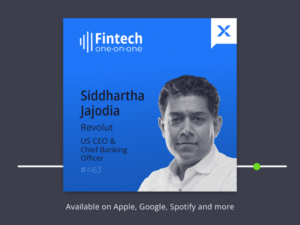Enjoying our podcasts? Don’t miss out on future episodes! Please hit that subscribe button on Apple, Spotify, YouTube, or your favorite podcast platform to stay updated with our latest content. Thank you for your support!
When you stop and think about it, it is kind of crazy that we don’t have a global network for moving money instantly and cheaply. The internet is more than 30 years old now and it seems to me that this should be a solved problem by now. But it isn’t, at least not yet.
My next guest on the Fintech One-on-One podcast is David Marcus, the CEO and Co-Founder of Lightspark. If David’s name sounds familiar that is because he was the leader of the now-defunct Libra/Diem project at Facebook a few years ago. He is passionate about creating a real-time global network for money movement which is why he founded Lightspark.


In this podcast you will learn:
- His fascinating background in tech.
- The thought process that went into the Libra/Diem project at Facebook.
- Why he decided to start Lightspark.
- An explanation of the Lightning Network that sits on top of Bitcoin.
- Why they chose to build their technology for the Lightning Network.
- What Lightspark actually does and who they are working with.
- Who is using their technology today.
- The potential throughput for number of transactions per second.
- How he thinks about solving micro-payments.
- The regulatory challenges that might come with reaching scale.
- Why we should think of what Lightspark is doing as an alternative payments rail.
- Why this is a technology play and nothing really to do with crypto.
- The potential use cases that can be developed.
- How he thinks about programmable money.
- Why it is important that payments systems behave just like the internet (open, real-time and interoperable).
- The different goegraphies where they have clients today.
- How their business model works.
- Why the combination of real-time payments and Lightning is so powerful for the last mile.
- What a future with real-time global payments could mean for commerce.
Read a transcript of our conversation below.
Episode 450: David Marcus, the CEO and Co-Founder of Lightspark
Peter Renton 00:01
Welcome to the Fintech One-on-One podcast. This is Peter Renton, Chairman and co-founder of Fintech Nexus. I’ve been doing this show since 2013, which makes this the longest running one-on-one interview show in all of fintech. Thank you for joining me on this journey. If you like this podcast, you should check out our sister shows, The Fintech Blueprint with Lex Sokolin and Fintech Coffee Break with Isabelle Castro, or listen to everything we produce by subscribing to the Fintech Nexus podcast channel.
Peter Renton 00:39
Before we get started, I want to remind you about our comprehensive news service. Fintech Nexus News not only covers the biggest fintech news stories, our daily newsletter delivers the most important fintech stories into your inbox every morning, with special commentary on the top story of the day. Stay on top of fintech news by subscribing at news dot fintech nexus.com/subscribe.
Peter Renton 01:10
We have a very special guest on today’s show, I am delighted to welcome David Marcus. He is the CEO and co-founder of Lightspark. Now if David Marcus’ name rings a bell, it’s because you probably know him as the president of PayPal or more likely, as the guy who was in charge of Libra/Diem that was coming out of Facebook a few years ago. Anyway, he is onto his new venture Lightspark, which I think is just extremely fascinating. What he is building, I didn’t really understand it until we chatted in this interview, and I get it now, and it is super exciting. Something, basically a new payments layer for the internet that’s global, that’s instant, that really doesn’t have anything to do with crypto. But it is built on the Bitcoin network and Lightning. So we’re going to talk all about it. Make sure you listen all the way to the end, it was really a fascinating discussion. Hope you enjoy the show.
Peter Renton 02:13
Welcome to the podcast, David.
David Marcus 02:15
Thanks for having me.
Peter Renton 02:16
My pleasure. So let’s get started by giving the listeners a little bit of background about yourself. You’ve been in tech for a long time, you’ve had some high profile positions. So give us some of the highlights.
David Marcus 02:29
Well, let’s see. I mean, I think I first define myself as an entrepreneur and as a startup founder. I started a number of companies. The last company I started I actually sold to PayPal, I ended up leading PayPal for a number of years, and then joined Facebook to lead Messenger and kickstarted the Libra/Diem project there. Left in December of ’21, and now started Lightspark last year.
Peter Renton 02:57
Right, right. Okay, so we’ll get into Lightspark in a little bit. Want to talk about your experience at Libra/Diem. What did you learn there? What are some of the takeaways from that? So like you’ve testified in front of Congress, I mean, it was a really big deal when this was launched. What did you learn? I’m particularly interested in sort of the payments lessons that might have been learned.
David Marcus 03:21
So first let’s let’s maybe elevate. The reason I was so passionate about starting something like Libra was really anchored in my deeply rooted frustration of the state of payment rails in, at the time 2018, but still the same in 2023. And basically, around the fact that there’s still no real time interoperable, global standard protocol for payments on the internet. You know, back in the days, there was like an HTTP 402 protocol that was kind of envisaged, but never implemented. We’ve basically successfully managed to build rails for everything that can be converted in zeros and ones on the internet, except for money. And in 2018, we still weren’t and we still aren’t now, in a place where you can send and receive money in the same way you would send or receive a text message or an email. And so we wanted to build something that was a global, open standard for payments on the internet. And we felt at the time that you know, Facebook’s reach of 3.5 billion consumers was a good way to convince a number of other companies to adopt a payment standard on the internet. And that’s why we did it from there and why we tried to build really good technology and capabilities and regulatory frameworks and the likes to make it happen. Unfortunately, politically, it just clearly wasn’t palatable to our lawmakers here in the US and even globally, and for a whole host of reasons that we can get into or not. But basically that’s what drove the project to a halt, and eventually, from that tech to be repurposed by others, but not launched in the form that we had hoped to launch it in with the Libra project.
Peter Renton 05:26
I want to move on to Lightspark, what was the genesis of the idea here? What’s the opportunity that you see?
David Marcus 05:32
Well, it’s basically the same, which is that, you know, in 2023, we’re still in a place where we still don’t have an open protocol for payments on the internet. And while we failed at trying to get Libra off the ground, everyone else that tried in the same period of time to do something similar, also failed. And it feels like almost something broken with the world, and something that I feel deeply passionate about fixing in my lifetime. And so decided to assemble the band again, and you know, they’re all feeling the same thing, which is the same sense of mission, to actually bring a protocol for payments on the internet that allows anyone to move value around the world on the internet, the same way that you move everything else on the internet. And this time around, we have taken all of the learnings that we’ve had from our past adventure, and decided that actually the the main network, or the only network that can actually support something like this would be Bitcoin, and I can I can dive into more details as to why, but basically Bitcoin as a net neutral form of internet money, that is, the settlement assets for a real time cash final payment network, was really an attractive technology to build on. And as such, we’ve decided to build on top of Bitcoin and more specifically on Lightning to enable real time payments on on top of the Bitcoin network.
Peter Renton 07:07
Right, right. I think if you asked us 20 years ago, whether we would be in a situation today, that where payments basically, sure there’s FedNow and there’s RTP, and there’s a couple other things that are doing moving things around fairly quickly, but still payments, basically the same as it was 20 years ago, as far as moving money instantly. Just doesn’t happen that much. So I share your frustration and and I feel like it’s kind of crazy that we’re in this situation. So I want to dive in and talk about the the Lightning Network, maybe you can explain what it is. I conceptualize it as like a layer two protocol on top of Bitcoin, like the Layer 2 protocols. We know many of them on top of Ethereum. Is that a good way to conceptualize it?
David Marcus 07:55
Yes, it’s a little bit nuanced and different, though, because Lightning, unlike rollups, or other forms of scaling Layer 2 protocols on top of Ethereum, is a channel based payment system and protocol on top of Bitcoin. So that means that basically, think of it as a maze of a series of abacuses like all over the world where you move beads from one side of the abacus to the other. And, you know, you have to basically open channels, payment channels between nodes, between different types of payment nodes on the network, lock up value in Bitcoin in those channels. And then you can move value around. So it turns out that it’s a really good solution to Bitcoin scaling problems, to finality times, to cost of transactions, because it makes basically Bitcoin transactions near real time, very, very low marginal cost, and cash final, so it settles really in real time. The problem with that is that it’s actually massively complex to operate. And that’s where Lightspark comes in, where we’ve basically automated and simplified how to onboard on the Lightning Network and made it behave like a regular payment network, basically, instead of it being this complicated maze of channels that you need to rebalance liquidity for all the time, and you need to route payments through. So we’ve basically abstracted the entire complexity, and not to get too in the weeds or too technical, but basically, we’ve basically built the equivalent of an original, you know, Cisco router for the internet. But you know, in this case for for Lightning basically, is what we’ve built.
Peter Renton 09:46
Right. So was Lightning really the very best option? I presume that’s what it was. Was it the only option? Could you have done this on Ethereum?
David Marcus 09:55
Well, we could have done this on other Layer 1s or other Layer 2 on top of Ethereum or other networks. The problem is that no other cryptocurrency has the regulatory clarity that Bitcoin has. No other currency has as much liquidity versus fiat and other assets out there. So you know, if you want Bitcoin or a fragment of a Bitcoin to be a settlement currency on top of a very fast network that Lightning is, but basically enabling it to carry any currency you want, then you need a lot of liquidity at the endpoints to be able to FX in and out of Bitcoin really quickly and cheaply. And having a lot of liquidity is actually a real asset. And you know, by far, by far, Bitcoin has a ton more liquidity on exchanges, wallets, liquidity providers, market makers, institutional players, compared to any other digital asset out there. And so the combination of the regulatory clarity, the massive amounts of liquidity and the fact that basically bitcoin is the most decentralized network out there by far, has a lot of advantages that can’t be replicated by other Layer 1s or other technologies.
Peter Renton 11:15
Okay, understood. So then should we think about Lightspark as sort of the, like a payments infrastructure layer for Bitcoin? And maybe you could explain it? That’s how you describe it to sort of lay people? And what products are you developing?
David Marcus 11:32
Yes. So basically think of Lightspark as an entry point to the Lightning Network that enables all kinds of different companies to build real time global payments experiences on top of the internet. So we’re trying to advance the Lightning Network to become the winning standard protocol for payments on the internet. And we’re basically providing software tools and services to companies so they can actually take full advantage of that.
Peter Renton 12:01
Right. So is there anything out in the wild right now, are you still sort of in the development phase?
David Marcus 12:06
Yeah, so we’ve basically onboarded a number of exchanges and wallets on the platform. And we’re continuing to do that. And basically, when you think about the existing state of the world of Lightning, is basically every exchange or wallet wants Lightning, but then when they start working on it, they find that it’s actually so complicated to not only enable as a feature, but also maintain because of the liquidity channel rebalancing, routing, and all of these complexities. And as such, a lot of them have basically held off on integrating because the value effort to effort ratio, it just wasn’t computing for them until now. And so we’re basically onboarding a lot of them. And we’re also building a roadmap that will enable more mainstream payments use cases to happen. But the first step is really enable all of the players out there that are currently moving Bitcoin on Layer 1, to move Bitcoin in real time at a low cost. So faster and cheaper, on top of Lightning on behalf of their customers, bring that liquidity to the network. And then we can build all kinds of more mainstream consumer payments, consumer facing payments experiences through our customers, because we’re not a consumer facing company, to enable all kinds of payments use cases that can’t happen. So a good example is something that we have on our website right now, which is a demo of streaming money. So we know of streaming all kinds of different things, streaming audio, streaming video, streaming, all kinds of zeros and ones, but certainly not of money. And we believe that actually, money should move on the internet the same way as everything else. So streaming money should be a concept that companies should enable for their stakeholders. And that would enable to unlock a tremendous amount of GDP that’s actually stuck by the limitations of our current rails. And we’re very excited about that, like this idea that if money moves in real time globally, and if you can move very small, small amounts of money globally in real time at a marginal cost, then you can unlock a lot of value for consumers, for companies, for all kinds of players globally.
Peter Renton 14:17
Right. So then, I don’t know if there’s other consumer applications right now that are using your technology, like live right now?
David Marcus 14:26
Yeah. So if you’re in Europe, or if you’re in the Middle East, or if you’re in the US, there are a number of exchanges, and wallets that are actually on our stack. And that will enable you to send and receive Bitcoin on Lightning in real time, in a very reliable way, irrespective of the transaction amounts that you want to send or receive. And so that’s kind of the very, very basic version of how you can experience our product. The next stages of it are going to be basically, you know, if you’re sending money cross border, can you send money cross border in whatever currency you want, at whatever increments you want? And do that very reliably. When you think about it, the cross border and global money flows are really not optimized. You know, there’s lots of real time, real time payment systems on the edges of those networks domestically. So you think of it, in Brazil you have Pix, in India you have UPI, in Europe you have SEPA, and so on and so forth. But the global transaction networks such as SWIFT and others, are really not real time systems. This is a correspondent banking system, it works on top of basically a series of mazes of accounts that are held in and across banks around the world. And then you have this messaging platform that passes messages across all of these financial institutions for that money to eventually be settled in batch processes at the end of a working day, that stops on Friday at 5pm. And so you know, that’s very ineffective. And basically all the downstream network effects of all of that money being kind of stuck on archaic rails like this is something that we hope we can help resolve.
Peter Renton 16:16
Right. And so I’m sure you’ve thought about the scale. And you did mention scale already, but I presume you have the capacity to run transactions at, like Visa and MasterCard type scale? Is that fair to say?
David Marcus 16:29
Yeah, the throughput of Lightning is actually really high. And as such, you can assume that you can run many thousands of transactions per second, you know, over a long sustained period of time. Not saying that it’ll take a long sustained period of time to get there, I’m saying like, you can sustain that kind of throughput for a very long time. There’s a lot of orchestration and complexity involved with that, including rebalancing liquidity and moving it around the network. And that’s basically a lot of the value that we bring to our clients is doing that dynamically, on the fly. We have a product that’s called Lightspark Predict that actually will predict the successful route for a specific transaction of a specific size and deploy liquidity on demand in real time across the entire network, to ensure that those transactions are successful. These things are actually really, really complex. But no one cares, right? It’s like, what they care is that they can plug into a simple interface and send money reliably. And then we’ll take care of that crazy complexity on our side.
Peter Renton 17:34
Right. Are you also thinking micro payments as a use case here, because it’s still crazy to me we haven’t solved that problem, either.
David Marcus 17:41
Yes, and the reason we haven’t solved that problem is basically because the cost of the transaction for a single micro payment is often higher than the amount you’re trying to transact in the first place. And as such, if you want micro payments to work in our current environment, then you need to preload a wallet with a set defined balance that you can then spend incrementally over time. And there are two problems with that. One, as a consumer, you need to commit to load up a wallet with $10 or $20. Two, is that wallet is actually going to be proprietary to one publication or to one domain. Because there’s no interoperability. That’s the other part we’re solving is interoperability between wallets, between banks, between platforms, will enable that global interoperability to happen in the same way that there’s interoperability between email providers on the internet with SMTP. So think of Lightning as a more complex version of SMTP. But for money.
Peter Renton 18:41
So, I mean, you’ve got to be acutely aware, given your history at Libra, of the political and regulatory challenges that lie ahead if something like this was to start to get scale. One of the things that the current environment that we’re living in with all, there’s a lot of negativity with crypto in Washington, although we are recording this today on the day where the SEC was defeated, federal judge said that Bitcoin ETF can go ahead. So that’s good news. But still, it seems like with all of the negativity around crypto, and the fact that if you, if this gets scale, do you think the Federal Reserve is going to be okay if there’s, you know, half the amount of volume flowing through your network as there is, or through the Lightning Network as there is through the federal payment system, and how do you how do you grapple with that?
David Marcus 19:33
Yeah, I think this is very different in nature for many reasons. First of all, the vision is actually that people will transact in their home currency like you know, dollars, euros, yen, etc. and not you know, with a stable coin that is, you know, controlled by an entity that is not the government, which was like a problem in the Libra construct. Despite the fact that we tried to devolve power into the association with 28 other members and all these things. So that wasn’t good enough. And so in this case, you can think of a fragment of Bitcoin traveling on Lightning like a TCP/IP packet for money. So we’re really focused on the infrastructure piece, and not so much on the asset that actually transits on top of the network. So I think that’s a key distinction. The other distinction is actually that, you know, when you think about payment systems out there, there’s a payment system that is controlled by the federal government in the US, which, you know, is basically, the window at the Fed, or now FedNow. And I think that’s one thing. But I think what when you look at all of the retail payment systems, they’re all in the hands of, you know, private companies today, whether it be banks or the PayPals of this world, or their Cash Apps of this world, or others, those are all private company operated payment systems. They just so happen not to be open, and not to be interoperable just because of the nature of the lack of actually an interoperability protocol for money on the internet, which is what we’re hoping to bring with with Lightning and Lightspark. So I think it’s a little different here, it’s basically making transactions cheaper, more efficient, bringing more competition to the payment landscape, in general. And trying to enable also use cases that are currently impossible because of the limitations of the current rails. You talked about micro payments, that’s definitely one of them. When you think about streaming of micro payments, that’s definitely a big use case for people who need to get paid. And you know, when you think about it, right now, payroll, or whether it’s like a gig worker getting paid, is artificially held up by the capabilities of our current payment systems. And so people are not basically getting paid as they perform a duty or a job. I think that could change. Global payouts and global payments, cross border payments has always been problematic, and very costly for populations that are typically more vulnerable and can’t afford to pay high fees, they end up paying the highest fees. All of these problems that are very, very big problems that are experienced by billions of people around the world can actually be solved by a real time open, interoperable, dirt cheap payment system or payment network on the internet.
Peter Renton 22:22
So then maybe we should think about this as just an alternative payment rail, where it sounds like what you’re saying is people are still going to transact in their local currency. And so this is just going to be the way that your money can flow, whether it’s domestically or internationally, that you’re you’re developing just an alternative rails. Is that how I should think about it?
David Marcus 22:43
Yeah, exactly. And, you know, when you think about the world today, you basically have a bunch of islands that are payment islands. They’re not connected by a hyperloop of payments, that makes it, you know, interoperable and real time and cash final, and all of that, right. So, in some cases, they’re, you know, rope bridges between some of these things that are, you know, really fragile and slow to travel on. But there’s no such thing as a global hyperloop of money on the internet that enables those islands to actually send value in real time 24/7, in whatever currency they want. And so I think that, you know, if you enable that, if you unlock that, then you can unlock a lot of GDP, for the lack of a better term, that’s actually, you know, locked up by the limitations of the current payment systems.
Peter Renton 23:35
Right, right. So I’m noticing, I’m on your website right now. And you don’t really mention crypto, you don’t really even mention Bitcoin, but you just talk about open payments at the speed of light. And, and so is that deliberate? I imagine it is, that this is sort of, you’re trying to put this as a, really it’s not a crypto play, it’s a technology play.
David Marcus 23:56
Yeah, absolutely. And, you know, when’s the last time that you thought of SMTP and TCP/IP, when you sent an email, right? It’s like you send an email, you have an interface, it’s nice, it’s easy to use, it works, right. And so that’s what we want payments to be on top of Lightning. And we don’t want you to have to basically do a special dance in the fire to be able to actually use a product because now you belong to a certain group of people who can figure out how to use a product. That’s definitely not, you know, not our approach to product.
Peter Renton 24:29
Right. So then, I’d love to kind of get your sense of how this is going to evolve. Are we going to have an app on our phone? Or is this going to be like a Chrome plugin that we’ll have? Once you start to get a lot of adoption here, what’s sort of going to be the…I imagine there’s gonna be lots of different use cases, right?
David Marcus 24:51
Yeah, that will really depend on our clients and the way that they bring the products to market right now. It’s in wallets that support Bitcoin because we move Bitcoin. Over time you can basically expect this to be in apps. So wallets and you know, eventually bank apps themselves, or Chrome extensions for streaming of money, whether it’s receiving or sending, by the way. So you can, you can imagine having all kinds of different endpoints that are basically on the Internet that will enable you to send or receive any finite amount of money on the Internet in real time. I mean basically, it’ll work the way that it should be working today already, and it’ll enable all kinds of value to travel on the Internet, encumbered only by regulatory obligations that we’re working hard to enable our clients to, of course, meet on top of a newish network.
Peter Renton 25:46
So then what do you think about the…a lot of people talk about the programmability of money with a lot of work being done on Ethereum. But is that part of what you’re developing? Or is this an abstracted away from that? I mean, I’m curious about it.
David Marcus 26:00
Yeah, it’s really abstracted away from it. I do think that there are interesting use cases for programmable money on top of what we’re doing, notably, on collateralization of assets, for access, broader access to capital, we think that that might be something that will be actually super relevant to a network that enables capital to travel globally, in real time in a really cheap way. But really, our focus right now is how can we build an open, interoperable, cheap protocol for payments on the internet that enables anyone to move money 24/7 at a very small sub atomic unit of whatever currency they want. And I think that if we can achieve that, then we can build all kinds of other things. But you know, that’s our, our laser focus is on that right now.
Peter Renton 26:48
Right, I remember, Chris Larsen, the founder of Ripple talking at one of our events many, many years ago now I think was like 2016, or ’17 basically said the same thing like the Internet of Money. Ripple’s Internet of Money, and clearly that hasn’t evolved quite like the way that they expected. So others have tried to do what what you’re trying to do now. What have you learned from those I guess, the failures, not that Ripple’s, Ripple’s still going of course, but what are you learning from the others that have attempted to do this?
David Marcus 27:18
Well, so the first thing is, I think you can’t build such a thing on a proprietary protocol that is controlled by a company. I think that’s the key learning. It has to behave like the internet, it has to be like the internet, and Lightning and Bitcoin respectively, and together behave like the internet. And so it’s an open protocol, we’re not going to be basically a monopoly, enabling companies to use this network, we’re going to have a ton of competition, and we already have a ton of competition, building different aspects and parts of the value chain on the network. And we’re also working with a bunch of other companies and parties on the same goal together, and in different ways. So it’s an open protocol. And as such, it’s not controlled by any one corporation or have outside influence of a single person, or a group of people that are identifiable, which is another virtue of Bitcoin. And so I think that’s kind of a key prerequisite. And that’s also one of the big reasons why we built on top of Bitcoin instead of anything else, frankly.
Peter Renton 28:25
And you’re obviously focused globally, I imagine. What companies you’re working with, is it primarily US? Is it all around the world, the companies you’re working with right now?
David Marcus 28:34
Yeah, it’s very global. So you know, we have clients in Latin America, we have clients in the Middle East, we have clients in Europe, here in the US. So we have clients all over the place, Africa actually ongoing right now. So we really, because our approach is actually the approach of building software services and capabilities on top of an open network that is global by nature, we don’t really have an area of focus in terms of a geographical area where we have concentration of clients, we have clients all over the place. And one of the interesting use cases, in the early days of our platform has been that actually if you’re buying a small amount of Bitcoin on an exchange, to move that small amount of Bitcoin on Layer 1 is actually very costly, versus larger transactions in the US. So we’ve had, we’ve had a lot more traction in the early days with the basic version of our product, the very first version of our product, in places where actually moving small amounts of Bitcoin were really on the critical path for a lot of these exchanges and wallets. And as such, we brought a solution that really met a big problem at the time they needed one.
Peter Renton 29:45
Right, right. So what’s your business model? Are you a SaaS company? Are people paying a subscription here?
David Marcus 29:50
So we are a SaaS company. It’s not really a subscription. It’s kind of, you know, we charge per API calls or you know, you can bring it down to a transaction level, but basically we provide the whole suite of services. So Lightspark Connect, which is our enterprise grade Node Management System for lightning nodes, Predict which enables the routing, and on demand liquidity to facilitate, you know, high, high availability and high success rate of transactions. Our SDKs, and APIs, and a suite of incoming services as well. So we package all of that, and you know, we charge a small fee, that is, you know, honestly very marginal compared to the cost of traditional payment networks, all in. And that’s how we monetize.
Peter Renton 30:40
Right, right. Okay. So I’m curious whether the, the instant payments you talked about, you’d mentioned Pix, you mentioned UPI, does this all help you to have all of these faster payment networks, because obviously, people were moving domestically inside Brazil. Pix is now the number one payment method. How does that help?
David Marcus 30:59
So it helps because the problem we’re trying to solve is actually global interoperability of those islands of money that we talked about. And if you can push money globally between these islands, but the last mile that enables you to actually use that balance is real time and low cost, then it makes the whole system work. If you were to push money to an endpoint, and then you have a balance, but you can only move that balance, you know, from Monday to Friday, eight to five, then you know, it’s not really a global Internet of Money that you can actually build on top of this combined infrastructure that combines basically the last mile real time payment systems and Lightning in the middle as an interoperability layer between all of these endpoints and accounts. And I think, you know, the combination of real time payment systems, and something like Lightning that works at scale with any currency is actually the powerful combination here.
Peter Renton 31:58
Right. Okay. So I want to close with a future looking question. Let’s just assume you’re wildly successful, and that everyone is using Lightning around the world. What’s…in 10 years time, what’s that gonna actually look like for the average consumer day to day?
David Marcus 32:16
Well, I think that’s a really good question. Because when you think, you talk to a lot of consumers, they can’t think of, you know, other ways to pay or get paid, or the value that can be unlocked instinctively, and especially if you’re in the US, you know, you have Venmo, you have PayPal, you have Cash App, you have all kinds of different ways to pay one another. You don’t feel like payments are a problem. The reality is, the way I think about this is, you know, back in the day, when people were sending faxes, and you know, word got out that there was a thing called the internet that was going to happen, and that was going to enable people to communicate in a in a more seamless way. People were also equally puzzled as to why is there a problem in communicating today, I can make a phone call, I can send a fax, it’s fine. And I think that, you know, people, you know, really can’t wrap their heads around, like what happens the minute you can actually move money digitally on the internet in a real time global way, and how much value can be unlocked. Another analogy is texting. Texting peaked across all of the mobile operators in the world at 20/25 billion messages a day. And now, any day, between, you know, WhatsApp and other messaging platforms out there, there’s hundreds of billions of messages that are sent and received. Because you know, now we have, you know, an ability to send unlimited messages on top of the internet.
David Marcus 32:45
And so the way I think about things is basically that it’s going to unlock a ton of trapped GDP, for people. So you’re going to be able to get paid much faster, cost of capital is going to go down, because capital is going to be more efficiently moving around the world, you’re going to be able to buy things and exchange value with people and entities that you can’t actually do that with today. So you’re going to be able to buy a series of services and goods that are out of reach today. And conversely, if you’re a company or an individual selling whatever it is that you’re selling, it’s art, it’s services, it’s capabilities, you’re going to be able to do it globally, seamlessly, without any afterthought of you know, where you can actually receive payments from. So I think you know, when you think about all of that, that’s a big difference in the world. And, you know, of course, you know, easier for us to wrap our heads around it like people who need to send money cross border today, still have trouble doing that. It’s very expensive. It’s very friction full. In some cases, people have to walk to places that are very unsafe and wait for hours to get cash out. All of these things don’t need to exist and you know, we believe that if you enable the network that can settle all of these transactions in real time at a fraction of the cost of the current system, you both bring new capabilities and reduce cost, then we can unleash a lot of value for billions of people.
Peter Renton 35:15
Okay, well, David, let’s leave it there. I hope you’re successful. And I want to solve this problem. And I really appreciate you coming on the show. I learned a lot today. Thanks a lot.
David Marcus 35:25
Thank you.
Peter Renton 35:27
Well, I hope you enjoyed the show. Thank you so much for listening. Please go ahead and give the show a review on the podcast platform of your choice and go tell your friends and colleagues about it. Anyway, on that note, I will sign off. I very much appreciate you listening, and I’ll catch you next time. Bye.
.pp-multiple-authors-boxes-wrapper.box-post-id-45383.pp-multiple-authors-layout-boxed.multiple-authors-target-shortcode.box-instance-id-1 .box-header-title { font-size: 20px !important; } .pp-multiple-authors-boxes-wrapper.box-post-id-45383.pp-multiple-authors-layout-boxed.multiple-authors-target-shortcode.box-instance-id-1 .box-header-title { font-weight: bold !important; } .pp-multiple-authors-boxes-wrapper.box-post-id-45383.pp-multiple-authors-layout-boxed.multiple-authors-target-shortcode.box-instance-id-1 .box-header-title { color: #000000 !important; } .pp-multiple-authors-boxes-wrapper.box-post-id-45383.pp-multiple-authors-layout-boxed.multiple-authors-target-shortcode.box-instance-id-1 .pp-author-boxes-avatar img { border-style: none !important; } .pp-multiple-authors-boxes-wrapper.box-post-id-45383.pp-multiple-authors-layout-boxed.multiple-authors-target-shortcode.box-instance-id-1 .pp-author-boxes-avatar img { border-radius: 5% !important; } .pp-multiple-authors-boxes-wrapper.box-post-id-45383.pp-multiple-authors-layout-boxed.multiple-authors-target-shortcode.box-instance-id-1 .pp-author-boxes-name a { font-size: 24px !important; } .pp-multiple-authors-boxes-wrapper.box-post-id-45383.pp-multiple-authors-layout-boxed.multiple-authors-target-shortcode.box-instance-id-1 .pp-author-boxes-name a { font-weight: bold !important; } .pp-multiple-authors-boxes-wrapper.box-post-id-45383.pp-multiple-authors-layout-boxed.multiple-authors-target-shortcode.box-instance-id-1 .pp-author-boxes-name a { color: #000000 !important; } .pp-multiple-authors-boxes-wrapper.box-post-id-45383.pp-multiple-authors-layout-boxed.multiple-authors-target-shortcode.box-instance-id-1 .pp-author-boxes-description { font-style: none !important; } .pp-multiple-authors-boxes-wrapper.box-post-id-45383.pp-multiple-authors-layout-boxed.multiple-authors-target-shortcode.box-instance-id-1 .pp-author-boxes-description { text-align: left !important; } .pp-multiple-authors-boxes-wrapper.box-post-id-45383.pp-multiple-authors-layout-boxed.multiple-authors-target-shortcode.box-instance-id-1 .pp-author-boxes-meta a span { font-size: 20px !important; } .pp-multiple-authors-boxes-wrapper.box-post-id-45383.pp-multiple-authors-layout-boxed.multiple-authors-target-shortcode.box-instance-id-1 .pp-author-boxes-meta a span { font-weight: normal !important; } .pp-multiple-authors-boxes-wrapper.box-post-id-45383.pp-multiple-authors-layout-boxed.multiple-authors-target-shortcode.box-instance-id-1 .pp-author-boxes-meta { text-align: left !important; } .pp-multiple-authors-boxes-wrapper.box-post-id-45383.pp-multiple-authors-layout-boxed.multiple-authors-target-shortcode.box-instance-id-1 .pp-author-boxes-meta a { background-color: #6adc21 !important; } .pp-multiple-authors-boxes-wrapper.box-post-id-45383.pp-multiple-authors-layout-boxed.multiple-authors-target-shortcode.box-instance-id-1 .pp-author-boxes-meta a { color: #ffffff !important; } .pp-multiple-authors-boxes-wrapper.box-post-id-45383.pp-multiple-authors-layout-boxed.multiple-authors-target-shortcode.box-instance-id-1 .pp-author-boxes-meta a:hover { color: #ffffff !important; } .pp-multiple-authors-boxes-wrapper.box-post-id-45383.pp-multiple-authors-layout-boxed.multiple-authors-target-shortcode.box-instance-id-1 .ppma-author-user_url-profile-data { color: #6adc21 !important; } .pp-multiple-authors-boxes-wrapper.box-post-id-45383.pp-multiple-authors-layout-boxed.multiple-authors-target-shortcode.box-instance-id-1 .ppma-author-twitter-profile-data span, .pp-multiple-authors-boxes-wrapper.box-post-id-45383.pp-multiple-authors-layout-boxed.multiple-authors-target-shortcode.box-instance-id-1 .ppma-author-twitter-profile-data i { font-size: 16px !important; } .pp-multiple-authors-boxes-wrapper.box-post-id-45383.pp-multiple-authors-layout-boxed.multiple-authors-target-shortcode.box-instance-id-1 .ppma-author-twitter-profile-data { background-color: #6adc21 !important; } .pp-multiple-authors-boxes-wrapper.box-post-id-45383.pp-multiple-authors-layout-boxed.multiple-authors-target-shortcode.box-instance-id-1 .ppma-author-twitter-profile-data { border-radius: 50% !important; } .pp-multiple-authors-boxes-wrapper.box-post-id-45383.pp-multiple-authors-layout-boxed.multiple-authors-target-shortcode.box-instance-id-1 .ppma-author-twitter-profile-data { text-align: center !important; } .pp-multiple-authors-boxes-wrapper.box-post-id-45383.pp-multiple-authors-layout-boxed.multiple-authors-target-shortcode.box-instance-id-1 .ppma-author-linkedin-profile-data span, .pp-multiple-authors-boxes-wrapper.box-post-id-45383.pp-multiple-authors-layout-boxed.multiple-authors-target-shortcode.box-instance-id-1 .ppma-author-linkedin-profile-data i { font-size: 16px !important; } .pp-multiple-authors-boxes-wrapper.box-post-id-45383.pp-multiple-authors-layout-boxed.multiple-authors-target-shortcode.box-instance-id-1 .ppma-author-linkedin-profile-data { background-color: #6adc21 !important; } .pp-multiple-authors-boxes-wrapper.box-post-id-45383.pp-multiple-authors-layout-boxed.multiple-authors-target-shortcode.box-instance-id-1 .ppma-author-linkedin-profile-data { border-radius: 50% !important; } .pp-multiple-authors-boxes-wrapper.box-post-id-45383.pp-multiple-authors-layout-boxed.multiple-authors-target-shortcode.box-instance-id-1 .pp-author-boxes-recent-posts-title { border-bottom-style: dotted !important; } .pp-multiple-authors-boxes-wrapper.box-post-id-45383.pp-multiple-authors-layout-boxed.multiple-authors-target-shortcode.box-instance-id-1 .pp-multiple-authors-boxes-li { border-style: solid !important; } .pp-multiple-authors-boxes-wrapper.box-post-id-45383.pp-multiple-authors-layout-boxed.multiple-authors-target-shortcode.box-instance-id-1 .pp-multiple-authors-boxes-li { color: #3c434a !important; }- SEO Powered Content & PR Distribution. Get Amplified Today.
- PlatoData.Network Vertical Generative Ai. Empower Yourself. Access Here.
- PlatoAiStream. Web3 Intelligence. Knowledge Amplified. Access Here.
- PlatoESG. Carbon, CleanTech, Energy, Environment, Solar, Waste Management. Access Here.
- PlatoHealth. Biotech and Clinical Trials Intelligence. Access Here.
- Source: https://www.fintechnexus.com/david-marcus-co-founder-ceo-of-lightspark-on-building-a-real-time-interoperable-global-standard-for-payments/
- :has
- :is
- :not
- :where
- $UP
- 1
- 10
- 20
- 20 years
- 2013
- 2016
- 2018
- 2023
- 28
- 30
- 300
- a
- abacus
- ability
- Able
- About
- about IT
- absolutely
- access
- Accounts
- Achieve
- across
- actually
- adopt
- Adoption
- advance
- ADvantage
- advantages
- Adventure
- africa
- again
- ago
- ahead
- All
- allows
- almost
- already
- also
- alternative
- Alternative Payments
- Although
- always
- am
- america
- amount
- amounts
- an
- anchored
- and
- Another
- any
- anyone
- anything
- api
- APIs
- app
- Apple
- applications
- appreciate
- approach
- apps
- archaic
- ARE
- AREA
- around
- Art
- AS
- aspects
- asset
- Assets
- Association
- assume
- At
- attempted
- attractive
- audio
- author
- Automated
- availability
- avatar
- average
- aware
- away
- back
- background
- Balance
- BAND
- Bank
- Banking
- banking system
- Banks
- based
- basic
- Basically
- BE
- because
- become
- been
- behalf
- being
- believe
- Bell
- below
- BEST
- Better
- between
- Big
- Biggest
- Billion
- billions
- Bit
- Bitcoin
- Bitcoin ETF
- Bitcoin Network
- bitcoin transactions
- Bloomberg
- blueprint
- bold
- border
- both
- Brazil
- Break
- bridges
- bring
- Bringing
- broader
- Broken
- brought
- build
- Building
- built
- Bunch
- business
- business model
- business news
- but
- button
- buy
- Buying
- by
- call
- called
- Calls
- CAN
- Can Get
- capabilities
- Capacity
- capital
- care
- carry
- case
- cases
- Cash
- Cash App
- Cash Out
- Catch
- Center
- ceo
- certain
- certainly
- chain
- chairman
- challenges
- change
- Channel
- channels
- charge
- cheap
- cheaper
- check
- choice
- chose
- Chris
- Chrome
- Cisco
- clarity
- clearly
- clients
- Close
- CNBC
- CNN
- Co-founder
- code
- Coffee
- Coin
- colleagues
- color
- combination
- combined
- combines
- come
- comes
- coming
- Commentary
- Commerce
- commit
- communicate
- communicating
- Companies
- company
- compared
- competition
- complex
- complexities
- complexity
- complicated
- comprehensive
- computing
- concentration
- concept
- Congress
- Connect
- connected
- construct
- consumer
- Consumers
- content
- continuing
- controlled
- Conversation
- conversely
- converted
- convince
- CORPORATION
- correspondent banking
- Cost
- costly
- could
- Couple
- course
- covers
- crazy
- Creating
- creator
- critical
- Cross
- crypto
- cryptocurrency
- curious
- Currency
- Current
- Currently
- Customers
- daily
- dance
- David
- David Marcus
- day
- Days
- deal
- December
- decentralized
- decentralized network
- decided
- define
- defined
- definitely
- delighted
- delivers
- Demand
- Demo
- deploy
- describe
- Despite
- details
- developed
- developing
- Development
- DID
- difference
- different
- digital
- Digital Asset
- Digital media
- digitally
- dirt
- discussion
- distinction
- dive
- do
- does
- Doesn’t
- doing
- dollars
- domain
- domestically
- done
- Dont
- DOT
- down
- dozens
- dynamically
- Early
- easier
- East
- easy
- effects
- efficient
- efficiently
- effort
- either
- ELEVATE
- else
- enable
- enables
- enabling
- end
- ended
- Endpoint
- endpoints
- enjoy
- enough
- ensure
- Enterprise
- Entire
- entities
- entity
- Entrepreneur
- entry
- Environment
- equally
- Equivalent
- especially
- etc
- ETF
- Ether (ETH)
- ethereum
- Europe
- Euros
- Even
- events
- eventually
- Every
- everyone
- everything
- evolve
- evolved
- exactly
- example
- Except
- exchange
- Exchanges
- excited
- exciting
- exist
- existing
- expect
- expected
- expensive
- experience
- experienced
- Experiences
- Explain
- explanation
- extensions
- extremely
- facilitate
- facing
- fact
- Failed
- fair
- fairly
- familiar
- far
- fascinating
- FAST
- faster
- Favorite
- fax
- Feature
- Fed
- Federal
- Federal government
- federal reserve
- fednow
- fee
- feel
- Fees
- felt
- few
- Fiat
- Figure
- final
- finality
- financial
- Financial institutions
- Financial Times
- Find
- fine
- fintech
- Fintech News
- Fire
- First
- five
- flow
- Flowing
- Flows
- Focus
- focused
- For
- For Consumers
- form
- forms
- forth
- Fortune
- Founded
- founder
- fox
- Fox Business
- fraction
- frameworks
- friction
- Friday
- friends
- from
- front
- frustration
- full
- future
- FX
- GDP
- General
- Genesis
- geographical
- get
- getting
- Give
- given
- Giving
- Global
- global network
- Global Payments
- Globally
- Go
- goal
- going
- good
- goods
- got
- Government
- grade
- Ground
- Group
- Guest
- Guy
- had
- Half
- Hands
- happen
- happens
- Hard
- Have
- having
- he
- heads
- Held
- help
- helps
- here
- High
- higher
- highest
- highlights
- him
- his
- history
- Hit
- Home
- Honestly
- hope
- hoping
- host
- HOURS
- hover
- How
- How To
- http
- HTTPS
- Hundreds
- Hyperloop
- i
- I’LL
- idea
- if
- imagine
- implemented
- important
- impossible
- in
- Including
- Incoming
- india
- individual
- influence
- Infrastructure
- inside
- instant
- instant payments
- instantly
- instead
- Institutional
- institutional players
- institutions
- Integrating
- interested
- interesting
- Interface
- internationally
- Internet
- Interoperability
- interoperable
- Interview
- interviewed
- into
- involved
- irrespective
- Islands
- IT
- Job
- joined
- joining
- journal
- journey
- judge
- just
- Key
- kickstarted
- Kind
- Know
- Lack
- landscape
- larger
- Larger transactions
- largest
- laser
- Last
- last mile
- Last Year
- latest
- Latin
- latin america
- launch
- launched
- lawmakers
- lay
- layer
- layer 1
- Layer 1s
- Layer 2
- Layer two
- lead
- leader
- leading
- LEARN
- learned
- learning
- least
- Leave
- left
- Lessons
- Level
- Libra
- lie
- lifetime
- light
- lightning
- Lightning Network
- Lightning Nodes
- like
- likely
- likes
- limitations
- Liquidity
- liquidity providers
- Listening
- little
- live
- living
- load
- local
- locked
- Long
- long time
- Look
- look like
- looking
- Lot
- lots
- love
- Low
- made
- Main
- Mainstream
- maintain
- make
- Makers
- MAKES
- Making
- managed
- management
- management system
- many
- Marcus
- Market
- market makers
- massive
- massively
- mastercard
- max-width
- maybe
- me
- mean
- means
- Media
- Meet
- Members
- mention
- mentioned
- message
- messages
- messaging
- Messenger
- met
- method
- micro
- micro-payments
- Middle
- Middle East
- might
- minute
- Mission
- Mobile
- model
- Monday
- monetize
- money
- more
- more efficient
- morning
- most
- move
- movement
- moves
- moving
- much
- my
- myself
- name
- Nature
- Near
- Need
- needed
- net
- network
- network effects
- networks
- Neutral
- never
- New
- New York
- New York Times
- news
- Newsletter
- next
- nexus
- nice
- no
- node
- nodes
- None
- normal
- notably
- note
- nothing
- now
- number
- obligations
- of
- off
- often
- Okay
- Old
- on
- Onboard
- Onboarding
- once
- ONE
- ones
- ongoing
- only
- open
- operate
- operated
- operators
- Opportunity
- optimized
- Option
- or
- orchestration
- original
- Other
- Others
- our
- out
- outside
- over
- package
- paid
- palatable
- part
- particularly
- parties
- parts
- passes
- passionate
- past
- path
- Pay
- paying
- payment
- Payment channels
- payment method
- payment networks
- payment system
- Payment Systems
- payments
- payments systems
- payouts
- PayPal
- Payroll
- People
- per
- perform
- period
- person
- Peter
- phase
- phone
- Phone call
- piece
- Place
- Places
- platform
- Platforms
- plato
- Plato Data Intelligence
- PlatoData
- Play
- players
- please
- pleasure
- plug
- plugin
- podcast
- Podcasts
- Point
- political
- politically
- populations
- positions
- potential
- power
- powerful
- predict
- president
- primarily
- private
- Private Companies
- probably
- Problem
- problems
- process
- processes
- produce
- Product
- Products
- Profile
- programmable money
- project
- proprietary
- protocol
- protocols
- provide
- providers
- providing
- Publication
- publications
- Push
- put
- question
- quickly
- Rail
- rails
- Rate
- ratio
- reach
- reaching
- real
- real-time
- real-time payments
- Reality
- really
- reason
- reasons
- rebalance
- rebalancing
- receive
- received
- receiving
- recording
- reduce
- regular
- regulatory
- relevant
- reliable
- remember
- replicated
- Reserve
- respectively
- retail
- review
- right
- Ripple
- roadmap
- Rollups
- rooted
- Route
- router
- routing
- RTP
- Run
- running
- SaaS
- Said
- same
- say
- saying
- Scale
- scaling
- sdks
- seamless
- seamlessly
- SEC
- Second
- see
- seems
- Selling
- send
- sending
- sense
- sent
- Sepa
- Series
- service
- Services
- set
- settle
- Settled
- settlement
- settles
- Share
- should
- show
- Shows
- side
- sign
- similar
- Simple
- simplified
- since
- single
- sister
- sits
- situation
- Size
- slow
- small
- So
- Software
- sold
- solid
- solution
- SOLVE
- solved
- Solving
- some
- something
- span
- special
- specific
- specifically
- speed
- spend
- Spotify
- stable
- stable coin
- stack
- stages
- stakeholders
- standard
- start
- started
- Starting
- startup
- State
- stay
- Step
- Still
- Stop
- Stops
- Stories
- Story
- streaming
- street
- subscribe
- subscription
- success
- successful
- Successfully
- such
- suite
- Super
- support
- sure
- sustained
- SWIFT
- system
- Systems
- Take
- Takeaways
- taken
- Talk
- talking
- Tcp/ip
- tech
- Technical
- Technologies
- Technology
- tell
- term
- terms
- testified
- text
- texting
- than
- thank
- thanks
- that
- The
- the Fed
- The Financial Times
- The Lightning Network
- The New York Times
- The State
- The Wall Street Journal
- the world
- their
- Them
- themselves
- then
- There.
- These
- they
- thing
- things
- think
- Thinking
- Thinks
- this
- those
- though?
- thought
- thousands
- Through
- throughput
- time
- times
- to
- today
- today’s
- together
- Ton
- too
- tools
- top
- Top Story
- traction
- traditional
- transact
- transaction
- Transactions
- transactions per second
- Transcript
- travel
- Traveling
- tremendous
- tried
- trouble
- trying
- turns
- two
- type
- types
- typically
- understand
- understood
- unfortunately
- unit
- unleash
- unlike
- unlimited
- unlock
- until
- updated
- UPI
- us
- use
- use case
- using
- value
- Venmo
- venture
- version
- Versus
- very
- Video
- visa
- vision
- volume
- Vulnerable
- wait
- walk
- Wall
- Wall Street
- Wall Street Journal
- Wallet
- Wallets
- want
- wanted
- wants
- was
- washington
- Way..
- ways
- we
- Website
- welcome
- WELL
- went
- were
- What
- whatever
- when
- whether
- which
- while
- WHO
- whole
- why
- Wild
- will
- window
- winning
- with
- without
- Word
- Work
- worker
- working
- works
- world
- world’s
- would
- wrap
- writing
- year
- years
- Yen
- yet
- york
- you
- Your
- yourself
- youtube
- zephyrnet








